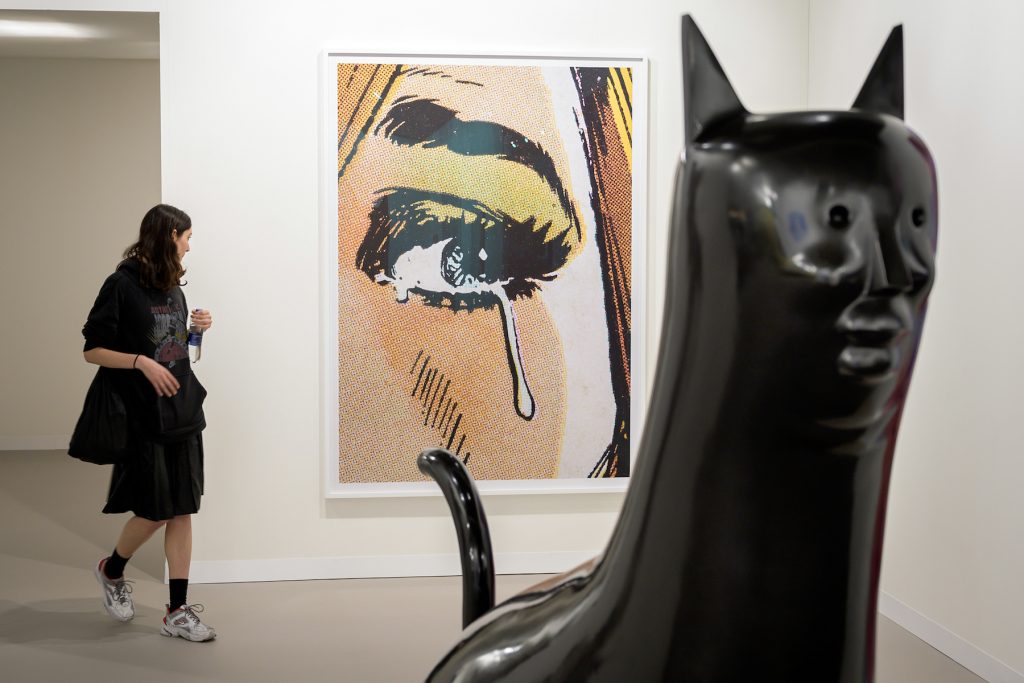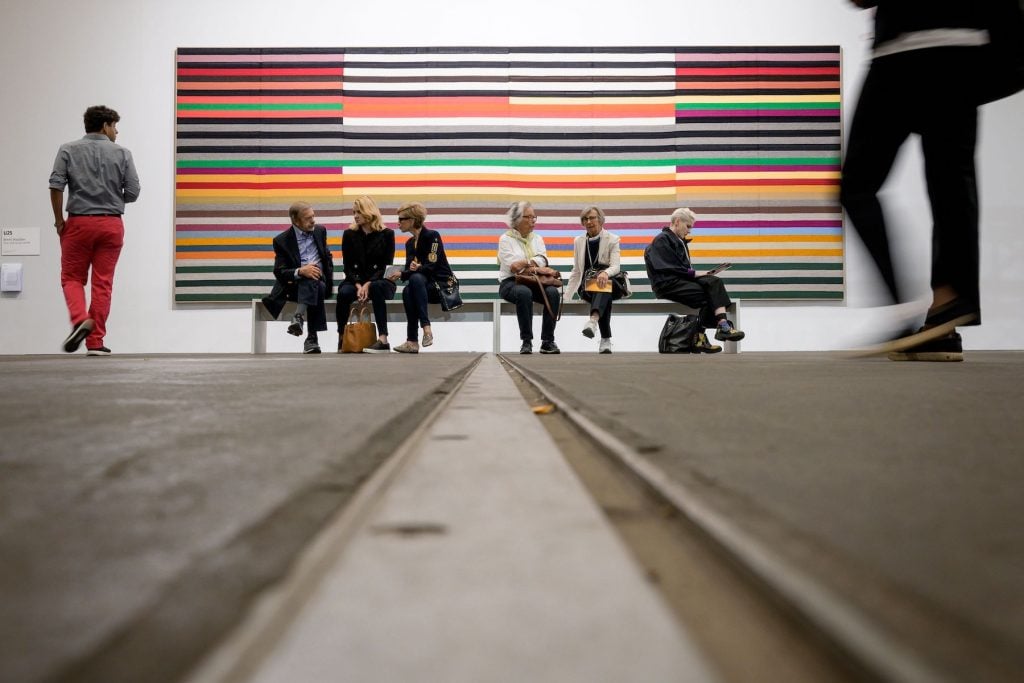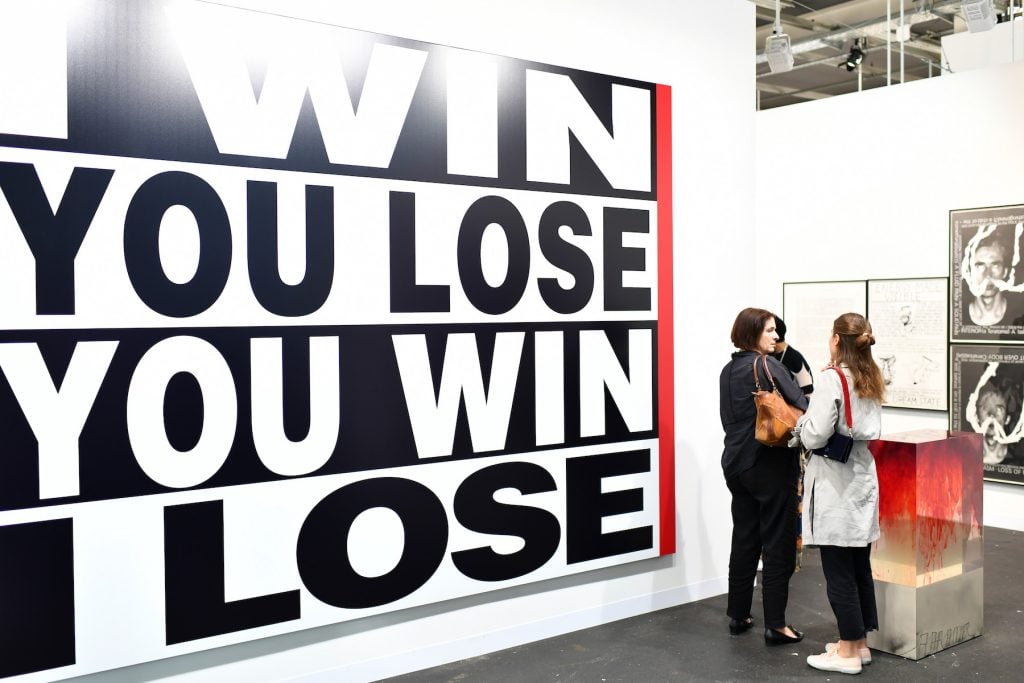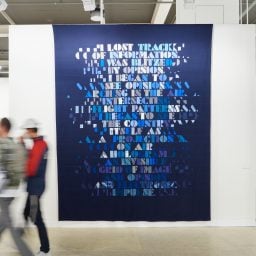Every Wednesday morning, Artnet News brings you The Gray Market. The column decodes important stories from the previous week—and offers unparalleled insight into the inner workings of the art industry in the process.
This week, trying to game out the unprecedented…
ALL FOR ONE, ONE FOR ALL (FOR ONCE)
On Monday, yours truly broke the news that Art Basel had established a CHF 1.5 million ($1.6 million) “one-time solidarity fund” for the galleries in its flagship Swiss fair just 15 days before the VIP opening. Every exhibitor will be able to opt into (or out of) the fund in the roughly two weeks between the end of the fair and the date Art Basel invoices for the balance owed for their booths, meaning only once they actually know the impossible-to-predict answer to the question of how their inventory will perform in a market that has shown selective strength throughout the pandemic.
While the benefit is significant even as a one-off, however, I’m even more interested in whether it could set a further-reaching precedent in the fair sector.
First, the context: Art Basel’s surprise policy shift arrives in response to exhibitors’ concerns about how the Delta variant and a raft of related, late-breaking health regulations could impact business at the company’s premier fair, which has not taken place in person since June 2019.
Apart from the central question of whether a critical mass of collectors will show up and pay up for artwork in an uneasy climate wrapped in red tape, dealers also recently learned that anyone who tests positive for COVID during the fair’s run could be required to quarantine in Switzerland for 10 days, a potentially costly outcome for dealers given the infamously high prices of lodging in Basel, to say nothing of last-minute airline change fees on international flights.
The letter, sent to exhibitors Monday by Art Basel global director Marc Spiegler and head of European business and management Andreas Bicker, sought to calm both fears. According to Art Basel’s calculations, if all 272 confirmed exhibitors were to opt into the solidarity fund, each would receive an additional 10 percent reduction on their square-meter booth rate. (That would bring the total decrease provided to exhibitors to 20 percent; they received an initial 10 percent reduction after committing to the fair in the spring.)
In addition to the solidarity fund, the letter also communicated that Art Basel will cover any additional costs incurred for hotel stays and travel rebooking should gallery staff test positive for COVID-19 during the run of the fair. Art Basel also expressed that it is continuing discussions with hoteliers in Basel, art shippers, and other third-party suppliers to “similarly support” exhibitors, though those conversations don’t yet appear to have yielded any tangible give-backs.
All of this is a lot to sort through, especially given how close to the event Art Basel rolled out these new benefits. While I’d love to deliver you one grand analytical framework to structure your thinking about them, the truth is that I had approximately 21 hours between the publication of the original story (on a holiday, no less) and my deadline for this column. (Online journalism: Soak up the glamor!)
Here, then, are the questions that leapt out to me at a glance as the most significant to consider while the industry tries to figure out what it all means—and what I can tell you so far.

A visitor arrives at the 2019 edition of Art Basel, the last in-person version of the fair. (Photo by Fabrice Coffrini/AFP via Getty Images.)
1. How Are Art Basel Exhibitors Reacting to the New Benefits?
By deadline time, I reached out to five U.S.- and U.K.-based dealers all showing in the fair’s main section for their snap takes on the policy. So far it is receiving high marks from within my (admittedly small) sample.
The first dealer to reply was Vanessa Carlos of London’s Carlos/Ishikawa. She was enthusiastic.
“Basel has really gone above and beyond what any other fair has offered so far,” she told me. “The idea of the fund especially is unprecedented, and something that talks to a larger issue beyond the pandemic that has been discussed in the art world for a really long time having to do with the disparity between art fair costs and potential profits amongst types of galleries.”
When I asked whether Carlos had any other concerns about the fair that were actually within Art Basel’s power to control but that were left unaddressed after Monday’s letter, she said no.
As for how she feels the global health scenario will impact collectors’ attendance, she said: “The virus is here for the long run. All we can do is get vaccinated and carry on living. A fair amount of European and U.S. collectors I know already told me they are traveling for it. Obviously conditions are different everywhere in the world—in Europe, there is a privileged access to vaccines, and many Europeans have been traveling this summer already.”
“I’m confident about taking part because of Basel‘s European geography combined with the amount of momentum Basel is always able to generate for its galleries,” Carlos continued. “Even just through its OVRs this past year, the Basel fairs brought us and our artists a lot of collectors during this time.”
Los Angeles gallerist Susanne Vielmetter (who will also have a booth in the fair’s main section) called the solidarity fund “very encouraging” and “definitely very much appreciated from our side.” She added that she “can imagine it will be especially helpful for younger galleries who are traditionally taking the largest risks in participating in the fair.”
“I cannot honestly think of anything else the fair can do at this juncture—we have all shipped our crates,” Vielmetter said. Still, it was “unclear yet” how many collectors will actually make the trip, she added—but she and her team are staying optimistic and bringing top-flight material to the fair regardless.
The policy received more support from Blum and Poe cofounder Tim Blum, as well as Kasmin senior director Eric Gleason. Blum agreed with Carlos and Vielmetter’s assessment that Art Basel has done all it could under the circumstances; Gleason called the solidarity fund “a pragmatic attempt at helping how they can” amid viral and governmental forces well outside the art world’s influence.
Blum and Gleason also expressed similar confidence regarding collector turnout, albeit with caveats.
“Everything remains to be seen, but I am confident that there will be a crowd of high-level collectors and strong representation from the art community coming to the fair,” Blum said.
Gleason, meanwhile, said that he and the Kasmin team “expect the fair to be lighter in attendance than usual with respect to American and Asian collectors. However, we also expect it to be very strong in terms of European collectors, which is a contingent with whom we have not been in the same room for a year and a half.”
The Bottom Line:
As far as I can tell right now, Art Basel’s exhibitors generally seem pleased about the new benefits being extended by the fair. Yet what will matter most is whether actual buyers materialize before and during the event. I’m sure Art Basel is mobilizing heaven and earth to try to ensure they do, but no one knows the answer for certain today.

A visitor looks at an artwork by Anne Collier entitled Woman Crying (Comic) #7 at Art Basel on June 12, 2019. (Photo by Fabrice Coffrini/AFP via Getty Images.)
2. How Likely Are Successful Exhibitors to Opt out of the Solidarity Fund?
It’s not quite accurate to say that the fund operates on the honor system; it will be managed by an independent auditor. But Art Basel will keep all information about participation in the fund private, so the public will only know if a given gallery opted in or out if that gallery voluntarily cranks up its megaphone and broadcasts its decision.
Crucially, the CHF 1.5 million total is fixed regardless of the number of dealers who choose to accept a share of the solidarity fund. This means the amount each gallery receives will rise with every gallery who opts out. (Smaller exhibitors are also poised to make up any cost deficits faster based on the sliding scale Art Basel implemented starting with the 2019 edition of its marquee fair; since that time, dealers renting larger stands have paid a higher square-meter rate than those renting smaller stands.)
“I’d like to think that the increased collegiality and cooperation that we’ve seen in the pandemic will lead to galleries being willing to pass that reduction on to their colleagues who need it,” Spiegler told me Monday.
So will they? What I know for sure is that Art Basel’s solidarity fund has kicked off one of the more interesting sociological experiments in the high-end art market. I could really see the results going either way.
Remember, wealthy people can be the cheapest people on the planet. (You don’t get rich signing checks, as an animated Bill Gates once half-jokingly said.) It’s not unusual for an elite gallery to shell out between $300,000 and $500,000 for their all-in Art Basel experience once the elaborate dinners, staff living expenses, and other supplementary costs pile onto the stand fees and actual artwork-related incidentals. A minimum 10 percent give-back on booth costs from Art Basel would still equate to several thousand bucks, and that’s not nothing in this context.
The wider world also gives us reason to be skeptical that virtue will automatically win out. When the U.S. federal government offered pandemic-relief business loans under the Paycheck Protection Program last spring, dozens of large, successful companies applied despite it being rather dubious that they genuinely needed cash.
Two of the most recognizable examples were Shake Shack (market cap: $2 billion) and Ruth’s Chris Steakhouse (market cap: $274 million), both of which are public companies that could have fundraised by selling stock rather than gobbling up taxpayer money earmarked for struggling small businesses. The Los Angeles Lakers, worth an estimated $3.7 billion on the private market, held their hand out too.
Although those three firms later returned a collective $34.6 million in PPP loans, it took a public shaming, the later threat of an audit, and the specter of prosecution to initiate the handover. So even if every elite dealer sells out their stand Art Basel 2021 stand, I would not guarantee they will all turn down a share of the solidarity fund, especially since they can opt in under cover of darkness.
On the other hand, even low-impact gestures of support for the common good tend to have outsized marketing value in the art business. Just look at the glowing press coverage that tends to ignite every time a mega-gallerist so much as holds a door open for a smaller dealer in public. (We at Artnet News have been as guilty of this as anyone. People love a feel-good story.)
Also, when it comes to sell-side responses to previous gallery-equity proposals in the fair sector, one of the most frequent and vociferous has been that no dealer wants to be seen as a charity case no matter how badly they could use the cash. A similar psychodynamic should apply here, though perhaps the pressure will be felt on the opposite side of the ledger. If you’re pumping out a press release about your “strong sales” (always so strong!) after Art Basel’s opening day, how seriously should anyone take your claims if you’re not also telegraphing your intention to opt out of the solidarity fund in the same salvo?
The Bottom Line:
I’d wager that many, if not most, dealers who do well at Art Basel will actually forgo a share of the solidarity fund, boosting the value of the benefit for less successful exhibitors. I just expect there will also be one or more cases where the draw of thrift, if not greed, overwhelms the cushion of strong sales and the warmth of mutual support.

Visitors seat in front of an artwork by Brent Wadden entitled Score 1 (Salt Spring) during a preview day of Art Base; on June 12, 2019. (Photo by Fabrice Coffrini/AFP via Getty Images.)
3. Will the Solidarity Fund Set an Art-Fair Precedent?
Art Basel has clearly framed the solidarity fund as a one-off benefit for a single, extraordinary set of circumstances. There are zero indications that it is meant as a pilot program that could become standard operating procedure once COVID-19 retreats into the ranks of run-of-the-mill, endemic illnesses.
Let’s assume for now that Art Basel stands its ground on the policy. Does it still put pressure on competitors, particularly Frieze London/Frieze Masters next month, to do the same ? Maybe, but maybe not, based on past history.
It’s true that Frieze announced it would introduce its own sliding scale for booth fees at the inaugural Frieze Los Angeles just a few days after Art Basel publicized its intentions for the same de facto square-footage subsidy at its events. But Frieze said the policy had already been under discussion internally for some time beforehand, and that its sections for younger galleries (such as Frame at Frieze New York) had long been priced more affordably than its main sections anyway. Regardless, to my knowledge, the sliding-scale policy has not spread much further through the fair sector in the years since.
Art Basel’s Art Market Principles and Best Practices, a combination of suggested guidelines for the fair’s participating galleries and a legal compliance process governing “cases involving intentional criminal activity directly related to an exhibitor’s professional art-market activities,” also seem to have spurred little wider response in the four years after their release. Together, these imperfect prior examples leave the waters murky in terms of the solidarity fund’s likely impact on Art Basel’s competitors.
Perhaps more important, however, is whether Art Basel could relent on the “one-time” aspect of the fund. As food for thought, Yuval Noah Harari, the author and thinker behind Sapiens (whose near-universal admiration in Silicon Valley and the D.C. political class make me wary of my own positive response to the book), wrote in a March 2020 op-ed that “temporary measures have a nasty habit of outlasting emergencies, especially as there is always a new emergency lurking on the horizon.”
Harari invoked this maxim to warn readers about accepting extraordinary government-surveillance measures proposed in the early days of COVID. He supported his unease by mentioning that his home nation of Israel implemented several supposedly temporary emergency measures during the 1948 War of Independence, ranging “from press censorship and land confiscation to special regulations for making pudding.” More than 70 years on, however, Israel still has not retired the emergency declaration and “has failed to abolish many of the ‘temporary’ measures of 1948.” (Legislators took care of the pudding thing in 2011, though.)
Meanwhile, travelers in the U.S. are still taking their shoes off at airport security checkpoints 20 years after 9/11 and a failed sneaker bomber attempt by Richard Reid. Ask Ed Snowden about how situational the intelligence establishment’s “war on terror” surveillance measures have turned out to be too.
I feel a little ridiculous offering up these grave examples to back up the idea that Art Basel’s solidarity fund could have a longer life than leadership intends right now. Still, put yourself in the shoes of an exhibitor committed to Art Basel Miami Beach this November. Barring an overwhelming change in Florida’s public-health picture (the state was averaging nearly 16,350 confirmed COVID infections per day as of September 7, according to the New York Times) , wouldn’t you make the case that you deserve the same benefit as your colleagues slated to man booths in Switzerland?
The Bottom Line:
As Vanessa Carlos alluded to, the solidarity fund does address a longstanding, significant structural problem in high-end art fairs. If it also proves to be as popular among exhibitors as the early returns suggest it could be—and if much of the fund indeed goes toward only the neediest galleries, without serious scandal—then Art Basel might feel it’s good business to find a way to change its tune on the fund’s longevity, especially in a climate where even major dealers (like the newly formed LGDR) are dialing their fair spend down to a single continent (Asia, in their case). It might not be likely, but it’s not impossible.
[Artnet News]
That’s all for this week. ‘Til next time, remember: everything is negotiable.











